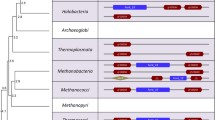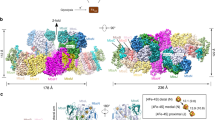Abstract
Protein disulfide oxidoreductases (PDOs) are redox enzymes that catalyze dithiol–disulfide exchange reactions. Their sequences and structure reveal the presence of two thioredoxin fold units, each of which is endowed with a catalytic site CXXC motif. PDOs are the outcome of an ancient gene duplication event. They have been described in a number of thermophilic and hyperthermophilic species, where they play a critical role in the structural stabilization of intracellular proteins. PDOs are homologous to both the N-terminal domain of the bacterial alkyl hydroperoxide reductase (AhpF) and to the eukaryotic protein disulfide isomerase (PDI). Phylogenetic analysis of PDOs suggests that they first evolved in the crenarchaeota, spreading from them into the Bacteria via the euryarchaeota. These results imply that the last common ancestor (LCA) of all extant living beings lacked a PDO and argue, albeit weakly, against a thermophilic LCA.




Similar content being viewed by others
Abbreviations
- PDOs:
-
protein disulfide oxidoreductases
- AhpF:
-
alkyl hydroperoxide reductase
- PDI:
-
eukaryotic protein disulfide isomerase
- LCA:
-
last common ancestor
References
Achenbach-Richter L, Gupta R, Stetter KO, Woese CR (1987) Were the original Eubacteria thermophiles? Syst Appl Microbiol 9:34–39
Altschul SF, Madden TL, Schaffer AA, Zhang J, Zhang Z, Miller W, Lipman DJ (1997) Gapped BLAST and PSI-BLAST: a new generation of protein database search programs. Nucleic Acids Res 25:3389–3402
Barion S, Franchi M, Gallori E, Di Giulio M (2007) First lines of divergence in the Bacteria domain were the hyperthermophilic organisms, the Thermotogales and the Aquificales, and not the mesophilic Planctomycetales. BioSystems 87:13–19
Beeby M, O’Connor BD, Ryttersgaard C, Boutz DR, Perry LJ, Yeates TO (2005) The genomics of disulfide bonding and protein stabilization in thermophiles. PLoS Biol 3:1549–1558
Brochier C, Philippe H (2002) A non-hyperthermophilic ancestor for Bacteria. Nature 417:244
Brochier C, Gribaldo S, Zivanovic Y, Confalonieri F, Forterre P (2005) Nanoarchaea: representatives of a novel archaeal phylum or a fast-evolving euryarchaeal lineage related to Thermococcales? (2005) Genome Biol 6:R42
Chuang MH, Wu MS, Lo WL, Lin JT, Wong CH, Chiou SH (2006) The antioxidant protein alkylhydroperoxide reductase of Helicobacter pylori switches from a peroxide reductase to a molecular chaperone function. Proc Natl Acad Sci USA 103:2552–2557
Di Giulio M (2003a) The universal ancestor and the ancestor of bacteria were hyperthermophiles. J Mol Evol 57:721–730
Di Giulio M (2003b) The ancestor of the Bacteria domain was a hyperthermophile. J Theoret Biol 224:277–283
Di Giulio M (2006) Nanoarchaeum equitans is a living fossil. J Theoret Biol 242:257–260
Felsenstein J (1989) PHYLIP—Phylogeny Inference Package (Version 3.2). Cladistics 5:164–166
Forterre P (1996) A hot topic: the origin of hyperthermophiles. Cell 85:789–792
Forterre P, Benachenhou-Lahfa N, Confalonieri F, Duguet M, Elie Ch, Labedan B (1993) The nature of the last universal ancestor and the root of the tree of life. BioSystems 28:15–32
Forterre P, Bouthier de la Tour C, Philippe H, Duguet M (2000) Reverse gyrase from hyperthermophiles: probable transfer of a thermoadaptation trait from Archaea to Bacteria. Trends Genet 16:152–154
Galtier N, Tourasse N, Gouy M (1999) A nonhyperthermophilic common ancestor to extant life forms. Science 283:220–221
Gogarten JP, Townsend JP (2005) Horizontal gene transfer, genome innovation and evolution. Nat Rev Microbiol 3:679–687
Gogarten-Boekels M, Hilario E, Gogarten JP (1994) The effects of heavy meteorite bombardment on the early evolution of life—a new look at the molecular record. Origins Life Evol Biosph 25:78–83
Hall TA (1999) BioEdit: a user-friendly biological sequence alignment editor and analysis program for Windows 95/98/NT. Nucleic Acids Symp Ser 41:95–98
Kanehisa M, Goto S (2000) KEGG: Kyoto encyclopedia of genes and genomes. Nucleic Acids Res 28:27–30
Klenk HP, Palm P, Zillig W (1994) DNA-dependent RNA polymerases as phylogenetic marker molecules. Syst Appl Microbiol 16:638–647
Kumar S, Tamura K, Nei M (2001) MEGA3: Integrated software for molecular evolutionary genetics analysis and sequence alignment. Brief Bioinformatics 5:150–163
Ladenstein R, Ren B (2006) Protein disulfides and protein disulfide oxidoreductases in hyperthermophiles. FEBS J 273:4170–4185
Lake JA, Herbold CW, Rivera MC, Servin JA, Skophammer RG (2007) Rooting the tree of life using nonubiquitous genes. Mol Biol Evol 24:130–136
Makarova KS, Koonin EV (2003) Comparative genomics of archaea: how much have we learned in six years, and what’s next? Genome Biol 4:115–145
Makarova KS, Koonin EV (2005) Evolutionary and functional genomics of the Archaea. Curr Opin Microbiol 8:586–594
Miller SL, Lazcano A (1995) The origin of life—did it occur at high temperatures? J Mol Evol 41:689–692
Murzin AG, Brenner SE, Hubbard T, Chothia C (1995) SCOP: a structural classification of proteins database for the investigation of sequences and structures. J Mol Biol 247:536–540
Nelson KE, Clayton RA, Gill SR, Gwinn ML, Dodson RJ, Haft DH, Hickey EK, Peterson JD, Nelson WC, Ketchum KA, et al (1999) Evidence for lateral gene transfer between archaea and bacteria from genome sequence of Thermotoga maritima. Nature 399:323–329
Pace NR (1991) Origin of life—facing up the physical setting. Cell 65:531–533
Pedone E, Ren B, Ladenstein R, Rossi M, Bartolucci S (2004) Functional properties of the protein disulfide oxidoreductase from the archaeon Pyrococcus furiosus. FEBS Eur J Biochem 271:3437–3448
Ren B, Tibbelin G, de Pascale D, Rossi M, Bartolucci S, Ladenstein R (1998) A protein disulfide oxidoreductase from the archaeon Pyrococcus furiosus contains two thioredoxin fold units. Nat Struct Biol 7:602–611
Schmidt HA, Strimmer M, Vingron M, von Haeseler A (2002) TREE-PUZZLE: maximum likelihood phylogenetic analysis using quartets and parallel computing. Bioinformatics 18:502–504
Skophammer RG, Herbold CW, Rivera MC, Servin JA, Lake JA (2006) Evidence that the root of the tree of life is not within the Archaea. Mol Biol Evol 23:1648–1651
Sleep NH, Zahnle KJ, Kastings JF, Morowitz NH (1989) Annihilation of ecosystems by large asteroid impacts on the early Earth. Nature 342:139–142
Stetter KO (1994) The lesson of archaebacteria. In: Bengtson S (ed) Early Life on Earth: Nobel Symposium No. 84. Columbia University Press, New York, pp 143–151
Stetter KO (2006) Hyperthermophiles in the history of life. Philos Trans R Soc Lond B Biol Sci 361:1837–1843
Tian G, Xiang S, Noiva R, Lennarz WJ, Schindelin H (2006) The crystal structure of yeast protein disulfide isomerase suggests cooperativity between its active sites. Cell 124:61–73
Thompson JD, Gibson TJ, Plewniak F, Jeanmougin F, Higgins DG (1997) The Clustal_X Windows interface: flexible strategies for multiple sequence alignment aided by quality analysis tools. Nucleic Acids Res 25:4876–4882
Wächstershäuser G (2006) From volcanic origins of chemoautotrophic life to Bacteria, Archaea and Eukarya. Philos Trans R Soc Lond B Biol Sci 361:1787–1808
Woese CR, Kandler O, Wheelis ML (1990) Towards a natural system of organisms, proposal for the domains Archaea, Bacteria, and Eucarya. Proc Natl Acad Sci USA 87:4576–4579
Wood ZA, Poole LB, Karplus PA (2001) Structure of intact AhpF reveals a mirrored thioredoxin-like active site and implies large domain rotations during catalysis. Biochemistry 13:3900–3911
Zhaxybayeva O, Lapierre P, Gogarten JP (2005) Ancient gene duplications and the root(s) of the tree of life. Protoplasma 227:53–64
Acknowledgments
We are indebted to Monsieur Bastien Bousseau and to Drs. Celine Brochier, Peter Gogarten, and Manolo Gouy for several useful references. Support from CONACYT-Mexico (Project 50520-Q) to A.L. and (52226) to A.B. is gratefully acknowledged.
Author information
Authors and Affiliations
Corresponding author
Additional information
Reviewing Editor: Martin Kreitman
Rights and permissions
About this article
Cite this article
Becerra, A., Delaye, L., Lazcano, A. et al. Protein Disulfide Oxidoreductases and the Evolution of Thermophily: Was the Last Common Ancestor a Heat-Loving Microbe?. J Mol Evol 65, 296–303 (2007). https://doi.org/10.1007/s00239-007-9005-0
Received:
Accepted:
Published:
Issue Date:
DOI: https://doi.org/10.1007/s00239-007-9005-0




